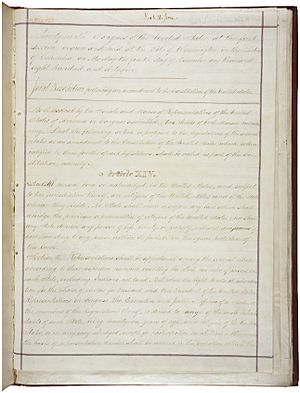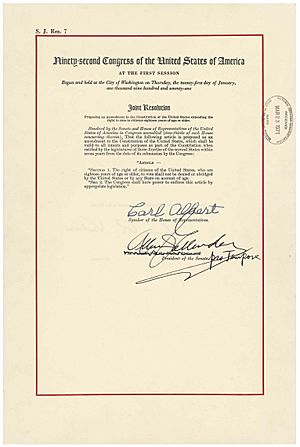Twenty-sixth Amendment to the United States Constitution facts for kids
The Twenty-sixth Amendment (also called Amendment XXVI) is a change to the United States Constitution. It lowered the minimum voting age in the United States from 21 years old to 18 years old.
The United States Congress approved this amendment on March 23, 1971. They sent it to the states to be approved, or ratified. It only took three months and eight days for enough states to ratify it. This made it the fastest amendment ever ratified in U.S. history.
Contents
What the 26th Amendment Says
Section 1. The right of citizens of the United States, who are eighteen years of age or older, to vote shall not be denied or abridged by the United States or by any State on account of age.
Section 2. The Congress shall have the power to enforce this article by appropriate legislation.
This means that if you are 18 or older, the United States government or any state government cannot stop you from voting because of your age. It also says that Congress can make laws to make sure this amendment is followed.
Why the Voting Age Changed
Early Ideas for Lowering the Voting Age
The idea of letting younger people vote wasn't new. During World War II, President Franklin D. Roosevelt lowered the age for the military draft to 18. This meant 18-year-old men could be forced to join the military.
Many people thought it was unfair. They felt that if young men were old enough to fight in a world war, they should be old enough to vote for the country they were fighting for. A popular slogan became: "Old enough to fight, old enough to vote."
Senator Harley Kilgore supported this idea in 1941. Other politicians, including First Lady Eleanor Roosevelt, also agreed. But Congress didn't make any changes then.
However, some states acted on their own. In 1943, Georgia lowered its state voting age to 18. Kentucky did the same in 1955. In 1954, President Dwight D. Eisenhower publicly supported lowering the voting age.
Growing Support for the Change
In the 1960s, more Americans pushed for the voting age to be lowered to 18. This was largely because of the Vietnam War. Many young men were drafted into the war before they were old enough to vote. They had no say in who sent them to war or why. The slogan "Old enough to fight, old enough to vote" became popular again.
Supporters also argued that 18-year-olds were treated as adults in other ways. For example, they had to pay income taxes. People argued this was "taxation without representation." This meant 18- to 20-year-olds paid taxes but couldn't vote on how those taxes were used.
In 1967, Representative William St. Onge said it ignored the idea of the War of Independence: "no taxation without representation." In 1970, Representative Thomas Railsback compared it to the Boston Tea Party.
Arguments Against Lowering the Voting Age
Not everyone agreed with lowering the voting age. Some people argued that teenagers were not mature or responsible enough to vote.
Others thought teenagers didn't know enough about history or politics to vote wisely. One historian mentioned a judge who said teens had "a terrible ignorance of even our own country's history."
Some also disagreed with the "old enough to fight, old enough to vote" argument. For example, Collier's Weekly magazine said in 1953 that this argument "doesn't justify giving young ladies of eighteen the right to franchise [vote]."
New York Times wrote in 1967 that a good soldier needs "youthful enthusiasm and physical endurance." But a good voter needs "maturity of judgment." They felt these were different things.
Finally, some people thought lowering the voting age wasn't that important. They believed each state should decide for itself.
The Voting Rights Act and a Court Case
In 1970, Senators Ted Kennedy and Mike Mansfield suggested changing the Voting Rights Act of 1965. They wanted to lower the voting age to 18 across the country. They argued that the Equal Protection Clause of the Fourteenth Amendment meant 18- to 20-year-olds should have equal voting rights.
President Richard Nixon agreed that the voting age should be lowered. However, he worried that Congress might not have the power to make states lower their voting age for state and local elections. He thought the Supreme Court might say this part of the law was unconstitutional.
Even with his concerns, President Nixon signed the change to the Voting Rights Act on June 22, 1970. This change required the voting age to be 18 for all federal, state, and local elections. After signing, Nixon asked the Attorney General to quickly get a court decision on whether the 18-year-old voting provision was constitutional.
About 17 states refused to change their voting ages to 18 after Nixon signed the law.
Oregon v. Mitchell
After Nixon signed the law, the states of Oregon and Texas challenged it in court. The case, Oregon v. Mitchell, went to the Supreme Court in October 1970.
The Supreme Court had to decide if Congress could force states to lower their voting age for state and local elections. The nine judges strongly disagreed. In the end, five judges agreed on a decision, but they had different reasons for it.
The Court decided that Congress could set the voting age for federal elections (like for President or Congress) at 18. But Congress could not set the voting age for state or local elections. This meant states could keep the voting age at 21 for their own elections if they wanted.
This created a big problem: states would have to keep two different lists of voters. One list for federal elections would include 18-year-olds. Another list for state and local elections would only include people 21 and older. This would be very confusing and expensive.
Making the Amendment Happen
After the Supreme Court's decision, everyone agreed that a Constitutional amendment was the best way to solve the problem. An amendment would set the voting age at 18 for all elections, everywhere. This would avoid the confusing two-list system.
Also, an amendment requires both Congress and the states to agree. Two-thirds of both parts of Congress must approve it. Then, three-fourths of the state legislatures (38 out of 50 states) must ratify it. This process is explained in Article Five of the Constitution. This way, Congress wouldn't be forcing states to do something without their agreement.
Most Americans supported the Twenty-sixth Amendment, according to Opinion polls. Even the New York Times changed its mind and supported it.
Congress Approves
On March 10, 1971, the United States Senate voted 94–0 to propose the amendment. On March 23, the United States House of Representatives voted 401–19 for it. Congress then sent the amendment to the states for ratification.
States Ratify the Amendment
It took only three months for 38 states to ratify the Amendment. This made it part of the Constitution. After that, five more states ratified it. Seven states never did.
Here's the order in which the states ratified the Amendment:
| Order | State | Date | ||||
|---|---|---|---|---|---|---|
| 1-5 | Connecticut, Delaware, Minnesota, Tennessee, Washington | March 23, 1971 | ||||
| 6-7 | Hawaii, Massachusetts | March 24, 1971 | ||||
| 8 | Montana | March 29, 1971 | ||||
| 9-11 | Arkansas, Idaho, Iowa | March 30, 1971 | ||||
| 12 | Nebraska | April 2, 1971 | ||||
| 13 | New Jersey | April 3, 1971 | ||||
| 14-15 | Kansas, Michigan | April 7, 1971 | ||||
| 16-18 | Alaska, Maryland, Indiana | April 8, 1971 | ||||
| 19 | Maine | April 9, 1971 | ||||
| 20 | Vermont | April 16, 1971 | ||||
| 21 | Louisiana | April 17, 1971 | ||||
| 22 | California | April 19, 1971 | ||||
| 23-25 | Colorado, Pennsylvania, Texas | April 27, 1971 | ||||
| 26-27 | South Carolina, West Virginia | April 28, 1971 | ||||
| 28 | New Hampshire | May 13, 1971 | ||||
| 29 | Arizona | May 14, 1971 | ||||
| 30 | Rhode Island | May 27, 1971 | ||||
| 31 | New York | June 2, 1971 | ||||
| 32 | Oregon | June 4, 1971 | ||||
| 33 | Missouri | June 14, 1971 | ||||
| 34 | Wisconsin | June 22, 1971 | ||||
| 35 | Illinois | June 29, 1971 | ||||
| 36-37 | Alabama, Ohio | June 30, 1971 | ||||
| 38 | North Carolina | July 1, 1971 | ||||
| Amendment added to the Constitution: July 1, 1971 | ||||||
| 39 | Oklahoma | July 1, 1971 | ||||
| 40-41 | Virginia, Wyoming | July 8, 1971 | ||||
| 42 | Georgia | October 4, 1971 | ||||
| 43 | South Dakota | March 4, 2014 | ||||
| Never voted on the Amendment | ||||||
| Florida, Kentucky, Mississippi, Nevada, New Mexico, North Dakota, Utah | ||||||
A Special Ceremony
On July 5, 1971, President Richard Nixon held a ceremony at the White House. He signed the Twenty-sixth Amendment to show his support. (A President doesn't actually have to sign an amendment for it to become part of the Constitution.)
During the ceremony, he spoke about his confidence in young Americans. He said he believed America's young people would bring "moral courage" and "high idealism" to the country. He felt they would help fulfill the "American Dream" for everyone.
See also
 In Spanish: Vigesimosexta Enmienda a la Constitución de los Estados Unidos para niños
In Spanish: Vigesimosexta Enmienda a la Constitución de los Estados Unidos para niños




